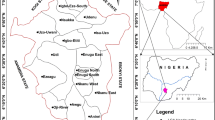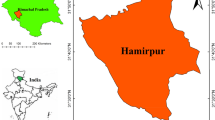Abstract
Integration of satellite-based remote-sensing data and the geographical information system (GIS) for the exploration of groundwater resources has developed a revolution in the field of groundwater research, which assists in evaluating, observing, and preserving groundwater resources. In the present paper, various groundwater potential zones for the assessment of groundwater recharge zone availability have been delineated using remote-sensing and GIS techniques. Landsat 8 satellite imageries were used to prepare various thematic layers such as: lithology, altitude, slope, and groundwater table map from the inventoried tube well data. These layers were then transformed into raster data using the feature to raster converter tool in the ArcGIS 9.3 software. The raster maps of these factors are allocated a fixed score and weight computed from multi-influencing factor (MIF) technique. Subjective weights are assigned to the respective thematic layers and overlaid in GIS platform for the identification of potential groundwater recharge zones within the study area using weighted overlay index analysis (WOIA). The groundwater potential zones thus obtained were divided into five categories, viz., very poor, poor, good, moderate, and excellent zones. The results reveal that the areas of excellent groundwater potential are estimated to permit precipitated water percolates into subsurface and ultimately contributes to recharge the groundwater. These results suggest that the high potential zones will have a key role in future expansion of drinking water and irrigation development in the study area.







Similar content being viewed by others
References
Acharya T, Nag SK (2013) Study of groundwater prospects of the crystalline rocks in Purulia district, West Bengal, India using remote sensing data. ER 1(2):54–59. doi:10.12966/er.07.03.2013
Al-Bakri JT, Al-Jahmany YY (2013) Application of GIS and remote sensing to groundwater exploration in Al-Wala Basin in Jordan. J Water Resour Prot 5:962–971. doi:10.4236/jwarp.2013.510099
Biswas A, Jana A, Sharma SP (2012) Delineation of groundwater potential zones using remote sensing and geographic information system techniques: a case study from Ganjam district, Orissa, India. Res J Recent Sci 1(9):59–66
Biswas A, Jana A, Mandal A (2013) Application of remote sensing, GIS and MIF technique for elucidation of groundwater potential zones from a part of Orissa coastal tract, Eastern India. Res J Recent Sci 2(11):42–49
Carver S (1991) Integrating multi-criteria evaluation with geographic information systems. Int J Geogr Inf Sci 5(3):321–339
Chatterjee RS, Bhattacharya AK (1995) Delineation of the drainage pattern of a coal basin related inference using satellite remote sensing techniques. Asia Pac Remote Sens J 1:107–114
Choudhury P (1999) Integrated remote sensing and GIS techniques for groundwater studies in part of Betwa basin. PhD thesis, Department of Earth Sciences, University of Roorkee (unpublished)
Choudhury K, Saha DK, Chakraborty P (2001) Geophysical study for saline water intrusion in a coastal alluvial terrain. J Appl Geophy 46(3):189–200
Chowdhury A, Jha MK, Chowdary VM (2010) Delineation of groundwater recharge zones and identification of artificial recharge sites in West Medinipur district, West Bengal, using RS, GIS and MCDM techniques. Environ Earth Sci 5:1209–1222
Das D (2000) GIS application in hydrogeological studies. http://www.gisdevelopment.net/application/nrm/water/overview/wato0003.htm. Accessed Dec 2016
Ganapuram S, Vijaya Kumar GT, Murali Krishna IV, Kahya E, Demirel CM (2009) Mapping of groundwater potential zones in the Musi basin using remote sensing data and GIS. Adv Eng Softw 40:506–518
Gautam PK, Biswas A (2016) 2D Geo-electrical imaging for shallow depth investigation in Doon Valley Sub-Himalaya, Uttarakhand, India. Model Earth Syst Environ 2(4):175
Ghosh PK, Bandyopadhyay S, Jana NC (2016) Mapping of groundwater potential zones in hard rock terrain using geoinformatics: a case of Kumari watershed in western part of West Bengal. Model Earth Syst Environ 2:1. doi:10.1007/s40808-015-0044-z
Hammouri N, El-Naqa A, Barakat M (2012). An integrated approach to groundwater exploration using re- mote sensing and geographic information system. J Water Resour Prot 4(9):717–724. doi:10.4236/jwarp.2012.49081
Horton RE (1945) Erosional development of streams and their drainage basins: hydrophysical approach to quantitative morphology. Geol Soc Am Bull 56:275–370
Kumar Ashok, Srivastava SK (1991) Geomorphological unit, their geohydrological characteristics and vertical electrical sounding response near Munger, Bihar. J Indian Soc Remote Sens 19(4):205–215
Magesh NS, Chandrasekar N, Soundranayagam JP (2012) Delineation of groundwater potential zones in Theni district, Tamil Nadu, using remote sensing, GIS and MIF techniques. Geosci Front 3(2):189–196
Maiti S (2013) Interpretation of coastal morpho dynamics of Subarnarekha estuary using integrated cartographic techniques. Curr Sci 104:12
Mitra M, Acharya T (2014) Study of groundwater prospect zones in metamorphic rocks in Purulia District, West Bengal—an approach from remote sensing and geographical information system. Curr Trends Technol Sci 3(6):402–407
Mukherjee S (2008). Role of satellite sensors in groundwater exploration. Sensors 8(3):2006–2016. doi:10.3390/s8032006
Nag SK (2005) Application of lineament density and hydrogeomorphology to delineate groundwater potential zones of Bagmundi Block in Purulia District, West Bengal. J Ind Soc Remote Sens 33(4):521–529
Nag S K (2008) Application of remote sensing and GIS in groundwater exploration. In: Ahmed S, Jayakumar R, Salih A (eds) Groundwater Dynamics in Hard Rock Aquifers, Springer, Netherlands, pp 87–92
Ravindran KV (1997) Drainage morphometry analysis and its correlation with geology, geomorphology and groundwater prospects in Zuvari Basin, South Goa, using remote sensing and GIS. Proc. nal sym-remote sensing for natural resource with special emphasis on water management, held at Pane during Dec. 4–6, 1996, pp. 270–296
Rokade VM, Kundal P, Joshi AK (2007) Groundwater potential modeling through remote sensing and GIS: a case study of RajuraTaluka, Chandrapur District, Maharashtra. J Geol Soc India 69(5):943–948
Saraf AK, Choudhury PR (1998) Integrated remote sensing and GIS for groundwater exploration and identification of artificial recharge sites. Int J Remote Sens 19(10):1825–1841
Sarkar BC, Deota BS, Raju PLN, Jugran DK (2001) A geographic information system approach to evaluation of ground water potentiality of Shamri Micro—watershed in Simla Taluk, Himachal Pradesh. J Ind Soc Remote Sens 20:3
Selvam G, Banukumar K, Srinivasan D, Selvakumar R, Alaguraja P (2012) Identification of ground water potential zone in hard rock terrain—a case study from parts of Manapparai block Tamilnadu using remote sensing and GIS techniques. Int J Adv Remote Sens GIS 1(1):8–18
Selvam S, Magesh NS, Sivasubramanian P, Soundranayagam JP, Manimaran G, Seshunarayana T (2014) Deciphering of groundwater potential zones in Tuticorin, Tamil Nadu, using remote sensing and GIS techniques. J Geol Soc India 84:597–608
Senanayake IP, Dissanayake DM, Mayadunna BB, Weerasekera WL (2016) An approach to delineate groundwater recharge potential sites in Ambalantota, Sri Lanka using GIS techniques. Geosci Front 7:115–124. doi:10.1016/j.gsf.2015.03.002
Shaban A, Khawlie M, Abdallah C (2006) Use of remote sensing and GIS to determine recharge potential zone: the case of Occidental Lebanon. Hydrogeol J 14(4):433–443
Sharma SP, Biswas A (2013) A practical solution in delineating thin conducting structures and suppression problem in direct current resistivity sounding. J Earth Syst Sci 122(4):1065–1080
Sharma D, Jugran DK (1992) Hydromorphological studies around Pinjaur-Kala Amb area, Ambala district (Haryana), and Sirmur district (Himachal Pradesh). J Indian Soc Remote Sens 29(4):281–286
Sharma SP, Biswas A, Baranwal VC (2014) Very low frequency electromagnetic method—a shallow subsurface investigation technique for geophysical applications. In: Sengupta D (ed) Recent trends in modeling of environmental contaminants. Springer, Netherland, pp 119–141
Singh A, Panda SN, Kumar KS, Sharma CS (2013) Artificial groundwater recharge zones mapping using remote sensing and GIS: a case study in Indian Punjab. Environ Manag 52:61–71
Singhal BBS (1963) Occurrence and geochemistry of ground water in the coastal region of Midnapur, West Bengal, India. Econ Geol 58(3):419–433
Subba Rao N, Chakradhar GKJ, Srinivas V (2001) Identification of groundwater potential using remote sensing techniques in and around Guntar town, Andhra pradesh, India. J Indian Soc Remote Sen 29(1&2):69–78
Thomas A, Sharma PK, Sharma MK, Sood A (1999) Hydrogeomorphological mapping in assessing groundwater by using remote sensing datada case study in Lehar Gage Block, Sangria district, Punjab. J Indian Soc Remote Sens 27:31–42
Tiwari A, Rai B (1996a) Hydrogeomorphological mapping for groundwater prospecting using landsat-MSS images—a case study of part of Dhanbad District. J Indian Soc Remote Sens 24(4):281–285
Tiwari A, Rai B (1996b) Hydromorphological mapping for groundwater prospecting using landsat-MSS images—a case study of part of Dhanbad District, Bihar. J Indian Soc Remote Sens 24:281–285
Acknowledgements
The authors gratefully acknowledge the University Grants Commission (UGC), India for financial support [Project No. F.PSW-10/12–13(ERO)]. The authors are also grateful to DPI, Higher Education Directorate, West Bengal, India, Prof. T.K. Karpha, Principal and Dr. A. Chatterjee, Head, Department of Geology of Hooghly Mohsin College for their constant cooperation and inspiration.
Author information
Authors and Affiliations
Corresponding author
Rights and permissions
About this article
Cite this article
Acharya, T., Kumbhakar, S., Prasad, R. et al. Delineation of potential groundwater recharge zones in the coastal area of north-eastern India using geoinformatics. Sustain. Water Resour. Manag. 5, 533–540 (2019). https://doi.org/10.1007/s40899-017-0206-4
Received:
Accepted:
Published:
Issue Date:
DOI: https://doi.org/10.1007/s40899-017-0206-4




